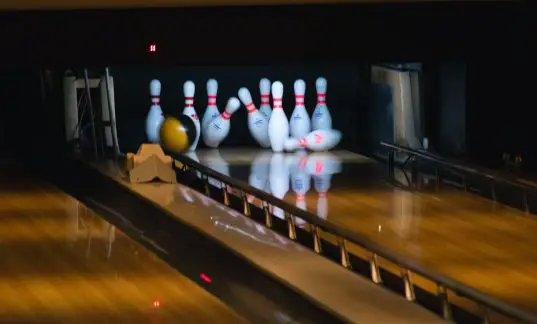Refining one’s bowling technique and finding bowling styles that work is the essential puzzle piece to take a bowler’s game to the next level. Whether you’re looking to put together a violent hook shot or find a way to throw a straight ball with efficacy, there are many different ways to find success at your local bowling alley. A bowling ball is just a tool. You use bowling balls to get the desired effects of pins crashing and scores tallying up.
From two-handed bowling to the most classic form of gripping it and ripping it, there is a litany of delivery styles and approaches for both young bowlers and older patrons to choose from. We’re here to present to you a bowling form and bowling technique primer, giving right-handed bowlers and left-handed bowlers alike a way to improve ball speed, increase strikes and spares, and make the first ball count more each time you play.
5 Bowling Forms To Try At The Local Bowling Alley
Stroker
The most used bowling form of them all, strokers are often deadly with both a strike ball and their backup ball. This popular style is all about balance and finding a groove where you feel comfortable throwing. Square your shoulders, resist the urge for a violent and higher backswing, and trust your accuracy over the allure of more revolutions. With proper wrist position, smart footwork to the right (or left) of your intended target, and a firm bowling hand, a bowler can zero in on the pocket and string strikes together.
Cranker
For those all about hitting more pins with more force, crankers turn cupped wrists and pronounced arm swings into big numbers. It’s all about revolution rate and hammering the pins with intent. Whether you’re shooting from the left side as a lefty or the opposite side with the opposite hand, it’s all about upping your speed and shot strength to the peak of your capabilities. If you hit wrong, you may be in for some splits. But when you find the right spot at the right speed, you’ll knock pins everywhere with strike after strike.
Power Stroker
If you’re kinda greedy and want to reap the benefits of the two styles we just talked about, you might want to try out the power stroker form. Focusing on maximum power (like a cranker) and precise spin and accuracy (like a stroker), a power stroker essentially fills the finger holes of a ball with liquid dynamite. And with a properly cupped wrist, there are few places behind the foul line that you won’t be able to do major damage.
Spinner
Ready to spin like a helicopter? This high-energy swing is all about upping your revolution rate rather than crushing pins with brute force. Many bowlers take this approach to increase pin action when oil conditions are just right. With a high rev rate and a strong axis rotation, you can put other bowlers to shame by using physics to your advantage. A spin delivery can be utilized with a one-handed or two-handed approach, with the latter using the off-hand as a guide.
Tweener
If you don’t fit into any of these bowling form boxes and want to tweak things a bit, playing with a tweener style is a great compromise. If you want fewer revs or more arm swing, you can adjust your shot as a tweener to get into a comfortable groove. You may end up sacrificing speed or overall pin carry, but a tweener form is perfect for those who understand their body and want to get through the grind of tournaments and high-level competition.
Now that you’ve got an overview of the five bowling forms to consider for use at the lanes, let’s take a closer look at your fingers and how they affect what you can accomplish.
3 Different Ways To Grip A Bowling Ball
Loose Grip
With a loose (or relaxed) grip, a bowler relaxes their thumb and guiding fingers as much as they can. There are both key benefits and drawbacks of setting out to bowl with a loose grip. If you struggle with aim, a loose grip can help you straighten your shot and hit the pocket with pinpoint accuracy. On the flip side, loose grips sink ships when it comes to hooking the ball and finding your maximum speed. You may pick up eights and nines with a loose grip, but the other pins might be just outside of your reach if you can’t slot the ball into the pocket perfectly each time.
Regular Grip
By firming up your grip just a bit, you can make a point of increasing revolutions and upping your overall ball speed. A regular grip gives you a bit more creativity to play with on the lane, allowing you to attack the breakpoint of a lane from different angles. You may not be able to produce a maximum hook or hit your speed limit with this grip. But, you can definitely find a spin-heavy groove that works for you.
Tight Grip
Ready to put the power of your wrists and hands to good use? Whether you throw from the right side, middle, or left side of the lane, a tight grip will help you take the lead in terms of high revolutions and breakneck speeds. It is much harder to control a ball thrown with a tight grip, though. With such great power, refined technique and form are essential. However, getting your tight grip and form down pat will lead to some of the craziest pin carry and high-impact crashes you’ve ever created at a bowling alley.
You’ve figured out your grip. You’ve got a good idea of the bowling form that works best for you. Now, it’s time to get your technique squared away.
3 Techniques To Turn Bowling Balls Into Wrecking Balls
Throwing A Straight Ball
Often associated with a loose grip, throwing a straight ball has some key advantages and disadvantages. It’s a fantastic approach for spares, allowing you to minimize variance and attack your angles head-on. However, straight-line throwing is a struggle when you’re trying to up your strike counts. Straight throws limit the overall movement you can create after impact, deadening the pins and leading to more eights, nines, and splits. With enough power, you can make it work. However, a hook shot is a much more effective way to go in the long run when it comes to first ball shooting.
Throwing A Regular Hook
A regular hook is pretty easy to discern on the lane. Left-handed bowlers tend to drop the ball on the left side of the lane, curving the ball right towards the 1-2 pin pocket. Right-handed bowlers usually drop the ball on the right side, hooking the ball into the 1-3 pin pocket. There are many types of hooks, both sweeping and sharp. In addition, oil conditions can alter the form and effectiveness of a hook shot. Yet, a hook shot is a killer first throw option when you get it down and angle the ball into the pocket with regularity.
Throwing A Reverse Hook
One of the hardest things to do effectively is to throw a reverse hook. For lefties, that means dropping the ball on the right side of the lane and curving it left into the 1-3 pocket. For righties, it means releasing the ball on the left side and sweeping it into the 1-2 pocket. We do not recommend throwing a reverse hook if you have wrist problems or deal with chronic pain in your arms. It requires an unnatural wrist snap and overall motion to pull off correctly. However, many bowlers with high rev rates love the violence they can create with a well-placed reverse hook.


